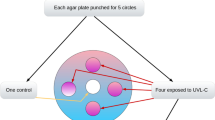Abstract
Aim
Streptococcus mutans has been detected as one of the most invasive microbial pathogens in oral disease. The aim of the present study is to evaluate the antimicrobial potential of 980 nm diode laser against S. mutans species.
Method
In this in vitro study, ATCC 10,662 strain of Streptococcus mutans was provided, incubated, and then cultured in blood agar. The specimen was divided randomly into 5 groups, one control group and four experimental groups with 1, 1.5, 2, and 3 w output power respectively. Antimicrobial surveillance was evaluated by a microtube test, and the resulted data were analyzed using SPSS 22.0 and with 0.05 significance.
Results
The results of the following study showed that the average and minimum growth rate of the groups was the same (100 w) but the maximum rate of growth was 0 in the 1.5 w group which was lower than the other groups (100 w). The difference between groups was not statistically significant (p = 0.722).
Conclusion
The findings of the following study suggested that using 980 nm diode laser could not significantly reduce S. mutans growth rate, so it is suggested to perform further investigations with more equipment and further modalities.
Similar content being viewed by others
References
Young DA, Nový BB, Zeller GG, Hale R, Hart TC, Truelove EL (2015) The American Dental Association Caries Classification System for clinical practice: a report of the American Dental Association Council on Scientific Affairs. J Am Dent Assoc 146(2):79–86
Philip N, Suneja B, Walsh L (2018) Beyond Streptococcus mutans: clinical implications of the evolving dental caries aetiological paradigms and its associated microbiome. Br Dent J 224(4):219–225
Balaji SM (2018) Dental caries: research perspective. Indian J Dent Res 29(1):3
Mathur VP, Dhillon JK (2018) Dental caries: a disease which needs attention. Indian J Pediatr 85(3):202–206
Lemos JA, Palmer SR, Zeng L, Wen ZT, Kajfasz JK, Freires IA, et al. The biology of Streptococcus mutans. Microbiol Spectr. 2019;7(1).
Lemos JA, Burne RA (2008) A model of efficiency: stress tolerance by Streptococcus mutans. Microbiology (Reading, England) 154(Pt 11):3247
Bottner A, He RY, Sarbu A, Nainar SMH, Dufour D, Gong SG et al (2020) Streptococcus mutans isolated from children with severe-early childhood caries form higher levels of persisters. Arch Oral Biol. 110:104601
Kovacs CJ, Faustoferri RC, Bischer AP, Quivey RG Jr (2019) Streptococcus mutans requires mature rhamnose-glucose polysaccharides for proper pathophysiology, morphogenesis and cellular division. Mol Microbiol 112(3):944–959
Seyedmousavi S, Hashemi SJ, Rezaie S, Fateh M, Djavid GE, Zibafar E et al (2014) Effects of low-level laser irradiation on the pathogenicity of Candida albicans: in vitro and in vivo study. Photomed Laser Surg 32(6):322–329
Grzech-Leśniak K, Nowicka J, Pajączkowska M, Matys J, Szymonowicz M, Kuropka P, Rybak Z, Dobrzyński M, Dominiak M (2019) Effects of Nd:YAG laser irradiation on the growth of Candida albicans and Streptococcus mutans: in vitro study. Lasers Med Sci 34(1):129–137
Wainwright M, Maisch T, Nonell S, Plaetzer K, Almeida A, Tegos GP et al (2017) Photoantimicrobials-are we afraid of the light? Lancet Infect Dis 17(2):e49–e55
Kıvanc BH, Arısu HD, Sağlam BC, Akça G, Gürel MA, Görgül G (2017) Evaluation of antimicrobial and thermal effects of diode laser on root canal dentin. Niger J Clin Pract 20(12):1527–1530
Estrela CRA, de Oliveira JD, Tirintan FC, Guapo-Pavarina R, Pereira TM, Bandeca MC et al (2018) Antimicrobial potential of laser diode in infected dentin. J Contemp Dent Pract 19(8):904–909
Brader HS, Young LH (2016) Subthreshold diode micropulse laser: a review. Semin Ophthalmol 31(1–2):30–39
Ahrari F, Shahabi M, Fekrazad R, Eslami N, Mazhari F, Ghazvini K et al (2018) Antimicrobial photodynamic therapy of Lactobacillus acidophilus by indocyanine green and 810-nm diode laser. Photodiagnosis Photodyn Ther 24:145–149
Basso FG, Oliveira CF, Fontana A, Kurachi C, Bagnato VS, Spolidório DMP et al (2011) In vitro effect of low-level laser therapy on typical oral microbial biofilms. Braz Dent J 22:502–510
Hakimiha N, Khoei F, Bahador A, Fekrazad R (2014) The susceptibility of Streptococcus mutans to antibacterial photodynamic therapy: a comparison of two different photosensitizers and light sources. J Appl Oral Sci 22(2):80–84
Characterization of antimicrobial photodynamic therapy-treated Streptococci mutans (2013) an atomic force microscopy study. Photomed Laser Surg 31(3):105–109
Author information
Authors and Affiliations
Corresponding author
Ethics declarations
Ethics approval
The study protocol was approved by the Urmia University of Medical Science Ethical Committee (Code: REC.UMSU.1397.421).
Conflict of interest
The authors declare no competing interests.
Additional information
Publisher's note
Springer Nature remains neutral with regard to jurisdictional claims in published maps and institutional affiliations.
Rights and permissions
About this article
Cite this article
Gabaran, Z.M., Taram, S., Karimi, J.R. et al. 980 nm diode laser irritation on Streptococcus mutans growth inhibition: in vitro study. Laser Dent Sci 6, 27–30 (2022). https://doi.org/10.1007/s41547-021-00140-z
Received:
Accepted:
Published:
Issue Date:
DOI: https://doi.org/10.1007/s41547-021-00140-z




